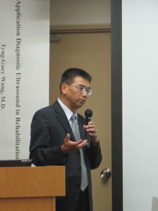Menu
- トップぺージ
- 講演会予定
- 過去の講演会
├令和6年
├令和5年
├令和4年
├令和3年
├令和2年
├平成31年
├平成30年
├平成29年
├平成28年
├平成27年
・第354回
・第353回
・第352回
・第351回
・第350回
・第349回
・第348回
・第347回
・第346回
・第345回
・第344回
・第343回
・第342回
・第341回
・第340回
・第339回
・第338回
・第337回
・第336回
・第335回
・第334回
・第333回
・第332回
・第331回
・第330回
・第329回
・第328回
・第327回
・第326回
・第325回
・第324回
・第323回
・第321回
・第320回
・第319回
・第318回
・第317回
・第316回
├平成26年
├平成25年
├平成24年
├平成23年
├平成22年
├平成21年
└平成20年
- オンデマンド講演会
過去の講演会
第339回川崎医学会講演会
| :: 日 時 | 平成27年7月8日(水) 17:30・18:30 | |
| :: 場 所 | 図書館小講堂 | |
| :: 座 長 | 花山 耕三 |
「Clinical Application of Diagnostic Ultrasound in Rehabilitation Medicine」
Tyng-Guey Wang, M.D.
Professor,
Department of Physical Medicine and Rehabilitation,
National Taiwan University, School of Medicine
With the advancement of imagining quality, digital processing and software, high-resolution ultrasound (US) has been widely used in the diagnosis and management of musculoskeletal disorders. The noninvasive nature of ultrasound makes it well accepted by the patients and physicians. Its dynamic application is unattainable in other modalities. Moreover, the internal structures of tendon and ligaments are better demonstrated by ultrasound rather than other image modalities. Synovial and cartilage thickness can be accurately quantified on sonogram, and providing a quantitative method of following up the effect of treatment. Joint effusion, loose body, tendonitis, as well as tendon and muscle rupture can all be well demonstrated sonographically. This lecture will cover the role of diagnostic ultrasound on musculoskeletal disorder. The diagnostic ultrasound (1) can help to make the differentiate diagnosis or confirmation of the causes of musculoskeletal pain; such as the intra-articular lesion vs extra-articular lesion, the severity of peri-articular tendon, ligament injury, (2) can help to make the decision of treatment strategy; such as the proper position of hand splint for carpal tunnel syndrome to keep the median nerve at the most relaxed position, (4) can help the direct treatment of musculoskeletal disorder; such as sono-guided aspiration and injection. Moreover, with the improving technology, ultrasound can define the characteristic of soft tissue and diagnose the soft tissue pathology before morphology change occurred. Ultrasound has been applied in assessment of swallowing function as well as to be a biofeedback tool in training some specific muscles recently. However, no matter how many benefits of diagnostic ultrasound on musculoskeletal disorders was told, the most sophisticated image study fail to reveal the exact status of soft tissue involvement. Nothing has yet replaced a delicate history and physical examination of the patients. Abnormal image study must confirm what the history and physical examination have suggested. The physician should treat the patient presenting with the symptom not the abnormal image findings.

